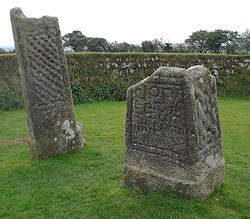
King Doniert's Stone
Encyclopedia

Donyarth
King Donyarth is thought to have been a 9th century King of Cornwall, now part of the United Kingdom.He is known solely from an inscription on King Doniert's Stone, a 9th century cross shaft which stands in St Cleer parish in Cornwall. His social status is not recorded there...
, King of Cornwall
Kingdom of Cornwall
The Kingdom of Cornwall was an independent polity in southwest Britain during the Early Middle Ages, roughly coterminous with the modern English county of Cornwall. During the sub-Roman and early medieval periods Cornwall was evidently part of the kingdom of Dumnonia, which included most of the...
who died around 875.
The site consists of the remains of two late 9th century granite cross-shaft fragments and an underground passage and chamber. The northern cross, termed the "Doniert Stone" is 1.37 metres high with panels of decoration on three sides and the inscription "doniert rogavit pro anima". The inscription translates as "Doniert has asked [for this to be made] for his soul[’s sake’]". The inscription is thought to refer to the local ruler "Dumgarth" (or "Dwingarth") who is recorded in the early Welsh chronicle known as the Annales Cambriae
Annales Cambriae
Annales Cambriae, or The Annals of Wales, is the name given to a complex of Cambro-Latin chronicles deriving ultimately from a text compiled from diverse sources at St David's in Dyfed, Wales, not later than the 10th century...
, as having drowned in around 875 AD. It has a mortise slot and a plinth at the base.
The southern cross, sometimes referred to as the "Other Half Stone", is 2.1 metres high with a panel of interlace decoration on the east face, a broken mortise slot at the top and a plinth at the bottom.
The underground rock-cut chamber begins as a passage about 8 metres to the south east of the crosses, turns into a tunnel and ends as a cruciform chamber beneath the crosses. The relationship between the underground chamber and the crosses is unknown.
The site is managed by the Cornwall Heritage Trust on behalf of English Heritage
English Heritage
English Heritage . is an executive non-departmental public body of the British Government sponsored by the Department for Culture, Media and Sport...
.

